Your solid perfume will typically last 12-24 months with proper storage and care. To maximize its lifespan, keep it in a cool, dry place between 15-25°C (60-70°F) and away from direct sunlight. You'll know it's time to replace your solid perfume when you notice changes in scent, texture, or color. Understanding how temperature, storage conditions, and ingredients affect your perfume's longevity can help you extend its life even further.
Understanding Solid Perfume Composition

Solid perfumes represent a unique blend of natural waxes, carrier oils, and fragrance compounds that work together to create a long-lasting scent experience.
At the heart of your solid perfume, you'll find beeswax as the primary base, which helps stabilize the fragrance and prevent quick evaporation. Currently priced at $21.00 for 250g, white beeswax is a top-rated ingredient choice for solid perfume making.
The composition includes carefully selected carrier oils like jojoba or sweet almond oil, which not only enhance the scent's longevity but also nourish your skin.
You'll also find moisturizing ingredients such as shea or cocoa butter, making the formula skin-friendly.
What sets solid perfumes apart is their higher concentration of fragrance oils compared to liquid alternatives.
This concentrated blend, combined with natural antioxidants like Vitamin E, guarantees your scent stays potent and fresh throughout the day.
The Science Behind Fragrance Longevity
The molecular structure of fragrances in solid perfumes affects how long they'll stay on your skin, with heavier molecules like amber and musk lasting markedly longer than lighter ones.
You'll notice that heat plays an essential role in the stability of these fragrance oils, causing them to break down more quickly at higher temperatures. A higher concentration of oil in solid perfumes helps them maintain their scent much longer than diluted varieties.
When solid perfumes are exposed to body heat at pulse points, the oils gradually release their scent molecules, creating a controlled and longer-lasting fragrance experience compared to liquid perfumes.
Molecular Structure and Stability
Understanding molecular structure helps explain why some fragrances last longer than others. Your solid perfume's longevity largely depends on the weight and complexity of its molecules. Heavier molecules, like those found in amber and musk, evaporate more slowly, giving you a longer-lasting scent.
When you're choosing a solid perfume, look for those containing patchouli, oud, or vetiver. These ingredients feature dense, complex molecular structures that resist quick evaporation. Perfumes with high oil concentrations tend to provide superior longevity compared to diluted formulations.
Synthetic molecules like Iso E Super and Galaxolide also contribute to extended wear. The presence of fixatives further enhances stability by anchoring volatile components.
You'll get the most staying power from formulas that combine these long-lasting molecules with proper concentration levels.
Heat's Effect on Oils
When exposed to heat, fragrance oils in your solid perfume undergo significant molecular changes that affect their stability and performance.
High temperatures accelerate the evaporation of essential oils and volatile compounds, causing your perfume to lose its potency faster than intended.
You'll notice that heat can transform your fragrance's character, often making it smell sour or less complex as the delicate balance of components breaks down.
The perfume's fixatives, which normally help stabilize the scent, struggle to maintain their effectiveness in elevated temperatures.
Even if you've invested in higher-concentration fragrances like EDP, they're still vulnerable to heat damage.
To protect your solid perfume's integrity, store it in a cool, dry place between 15°C-25°C, away from direct sunlight and heat sources.
This will help preserve its original scent profile and extend its lifespan.
Essential Storage Requirements
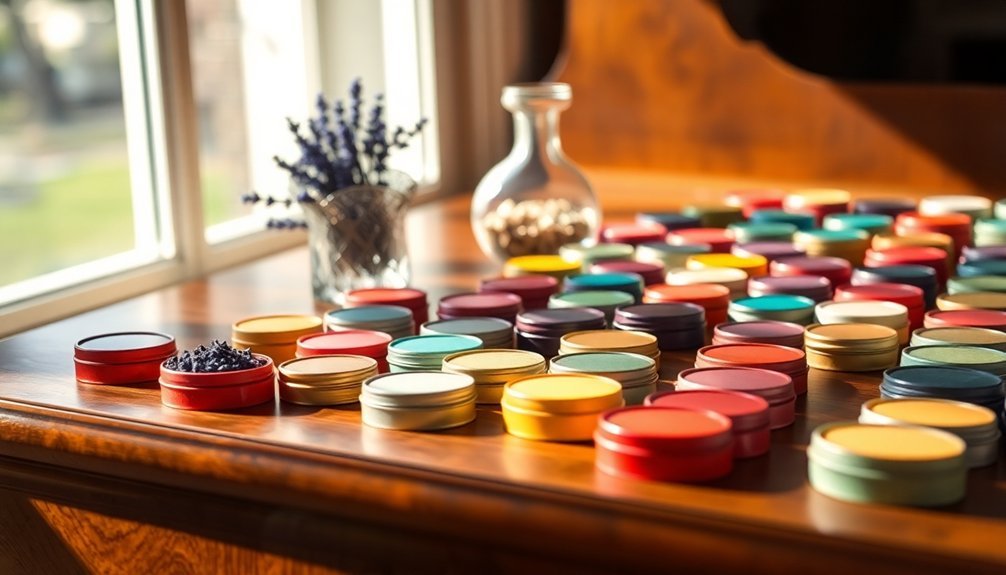
To maximize your solid perfume's lifespan, you'll need to store it in a consistently cool environment between 60-70°F (15-21°C) away from heat sources and temperature fluctuations.
You should keep your solid perfume in an opaque or dark-colored container that blocks harmful UV rays, which can break down the fragrance compounds.
For the best preservation, guarantee your solid perfume's container has an airtight seal to prevent oxidation and maintain the integrity of the scent.
Temperature and Environment Control
Proper temperature and environment control are critical factors in preserving your solid perfume's quality and longevity.
You'll want to keep your perfumes in a stable environment between 15°C and 25°C, away from areas prone to temperature fluctuations. Don't store them near radiators, heaters, or in your car, as extreme temperatures can melt or damage the product.
Key environmental factors to monitor:
- Keep your perfumes away from humid spaces like bathrooms to prevent them from becoming mushy
- Store in cool, dry places to maintain fragrance integrity
- Confirm your hands are dry before application to prevent moisture contamination
- Check your perfumes regularly for any signs of degradation
Remember that both heat and moisture can greatly impact your solid perfume's scent, texture, and overall performance.
Light Protection Methods
Since light exposure can greatly degrade your solid perfume's fragrance compounds, implementing effective light protection methods is essential for preserving its quality. You'll want to store your perfumes in opaque containers, preferably aluminum tins that shield against both light and humidity. Keep them in dark cabinets or drawers away from windows and direct sunlight.
| Storage Do's | Storage Don'ts |
|---|---|
| Use dark containers | Place near windows |
| Store in closets | Keep in bathrooms |
| Choose stable temps | Expose to sunlight |
| Use aluminum tins | Use clear containers |
| Pick dark drawers | Store in humid areas |
Airtight Container Solutions
When storing solid perfumes, airtight containers serve as your first line of defense against fragrance degradation.
You'll want to choose containers made from durable materials like glass or stainless steel, as they provide superior protection against oxidation and environmental factors.
Look for options with automatic sealing mechanisms to guarantee maximum air-tightness and preservation of your perfume's chemical composition.
Key features to take into account in airtight containers:
- Stackable designs that optimize your storage space
- Different size options to accommodate various perfume volumes
- Compartmentalized sections to keep fragrances separate
- Clear labeling areas for easy identification
Remember to pair your airtight container with proper environmental conditions, maintaining temperatures between 55-72°F and controlling humidity levels.
This combination will greatly extend your solid perfume's shelf life.
Signs Your Solid Perfume Has Expired
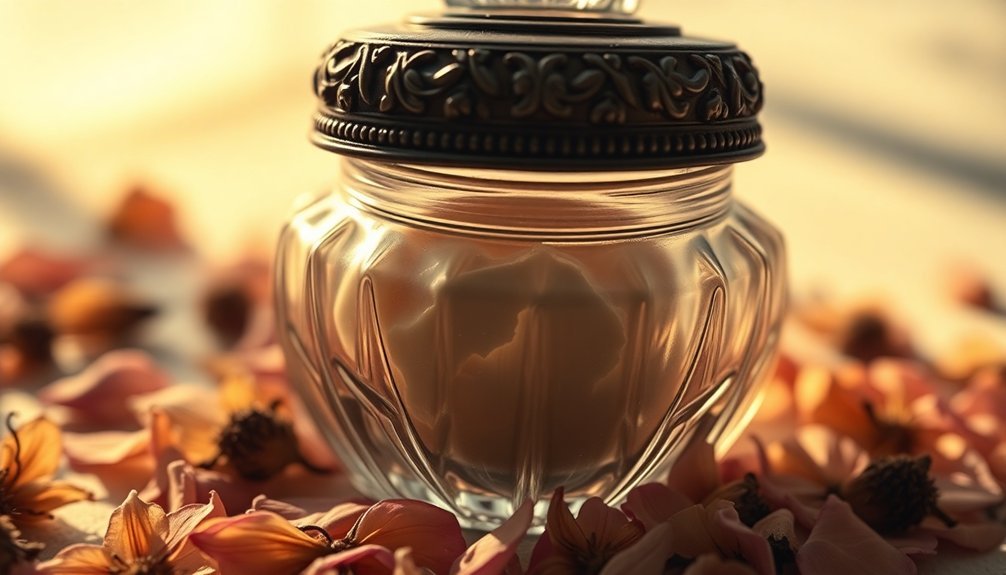
Determining whether your solid perfume has expired doesn't require a chemistry degree – several telltale signs can alert you to degradation.
Watch for changes in the perfume's original scent, which often becomes less potent or takes on an unusual odor over time.
You'll want to examine the perfume's appearance closely. If you notice any discoloration, yellowing, or cloudiness, your solid perfume is likely past its prime.
The texture should also remain consistent – if it's become thicker, oilier, or developed an unusual consistency, it's time for a replacement.
Pay attention to how the perfume performs on your skin. Expired products may not absorb properly or might lose their fragrance quickly.
While high-quality ingredients can extend shelf life, all solid perfumes eventually degrade, especially with frequent exposure to air and improper storage.
Temperature Effects on Solid Perfumes
Your solid perfume offers unique heat-resistant properties compared to liquid fragrances, as its wax base prevents rapid evaporation even in warmer temperatures.
You'll find that solid perfumes maintain their scent integrity better than liquid alternatives during temperature fluctuations, thanks to their concentrated fragrance oils and protective wax matrix.
To maximize these benefits, you can store your solid perfume in a cool, dark place, which will help preserve its fragrance compounds and extend its overall lifespan.
Heat Resistance Advantages
Despite their wax-based formulation, solid perfumes face unique challenges when exposed to high temperatures. When exposed to heat, your solid perfume's texture and consistency can soften or melt, impacting both its composition and effectiveness.
Heat exposure can also degrade fragrance oils, leading to reduced scent intensity and longevity.
Key heat resistance considerations for your solid perfumes:
- Store in cool, dry places away from direct sunlight to maintain ideal consistency
- Be prepared for more frequent reapplication in warm environments
- Monitor changes in texture that might indicate heat damage
- Consider seasonal storage solutions to protect your fragrance investment
While solid perfumes offer advantages over their liquid counterparts, proper storage is essential.
Understanding these heat-related challenges will help you preserve your solid perfume's quality and extend its lifespan.
Cold Storage Benefits
While proper temperature control plays an essential role in preserving solid perfumes, cold storage offers specific benefits for maintaining their quality.
When you store your solid perfumes in a cool environment between 15°C and 77°F, you'll help maintain their texture and prevent unwanted changes in their appearance. You'll avoid the formation of bloom or sweat on the surface, which can make your perfume look grainy or rough.
Cool, consistent temperatures also protect your solid perfume's fragrance profile from degrading. By keeping your perfumes in a stable, cool environment away from temperature fluctuations, you'll maximize their shelf life and maintain their scent strength.
Just remember not to store them in extremely cold conditions, as this can still affect their texture and performance.
Maximizing Your Solid Perfume's Lifespan
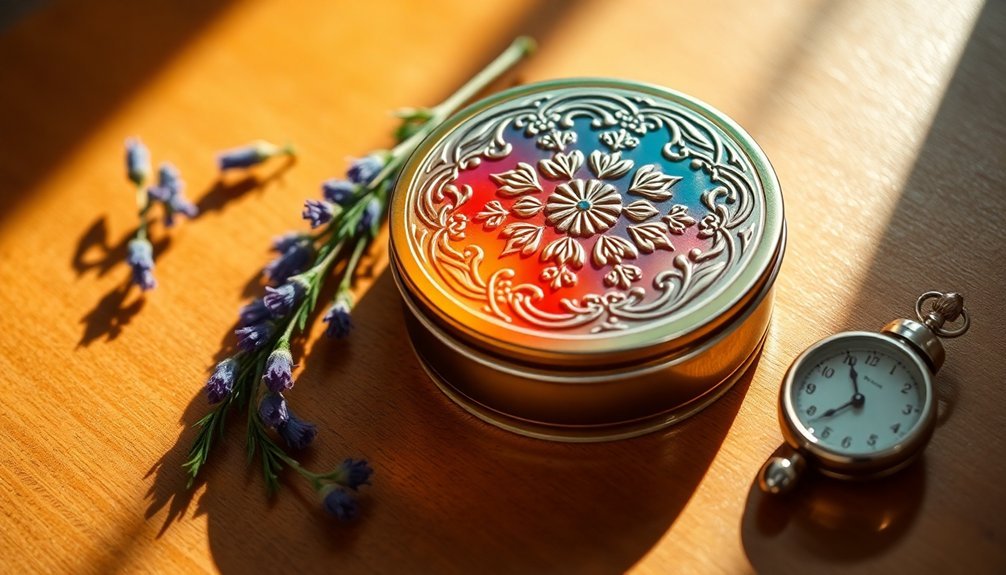
To maximize the lifespan of solid perfumes, several key factors work together to maintain their quality and potency. By understanding and controlling these elements, you'll get the most out of your fragrance investment.
- Store your perfume in a cool, dry place away from direct sunlight to prevent degradation.
- Apply to moisturized skin at pulse points for ideal scent longevity.
- Layer with complementary scented products to enhance staying power.
- Keep containers tightly sealed to protect against air exposure.
Your application technique plays an essential role in preserving your solid perfume. Make sure your skin is properly hydrated before applying, and use gentle, controlled motions to prevent product waste.
Remember that environmental factors like temperature and humidity can greatly impact your perfume's performance, so maintain consistent storage conditions for the best results.
Best Containers for Solid Perfume Storage
Selecting the right container for your solid perfume can greatly impact its longevity and usability.
A well-chosen container protects your solid perfume investment and ensures the best possible fragrance experience over time.
You'll find that aluminum tins offer an excellent balance of durability and affordability, while premium materials provide a more luxurious experience. If you're environmentally conscious, look for biodegradable or recyclable options.
Choose containers that are compact and travel-friendly, especially flat-shaped designs that easily slip into purses or pockets.
You'll want something that prevents spills and can withstand daily handling. Consider containers that protect your solid perfume from direct sunlight and extreme temperatures, as these factors can degrade the fragrance over time.
For maximum value, opt for containers you can reuse or refill.
Store them in a cool, dry place to maintain the quality of your solid perfume.
Environmental Factors Affecting Shelf Life
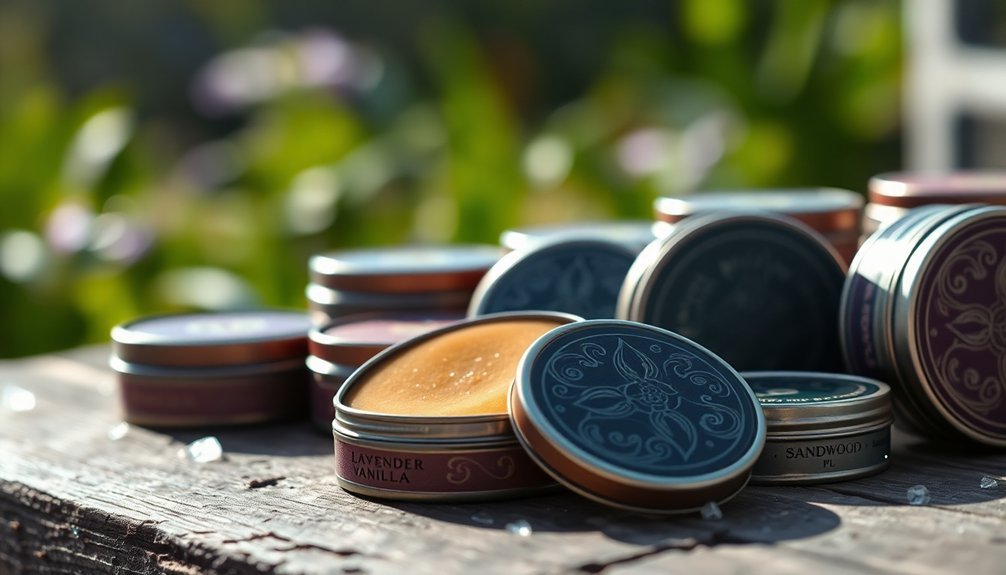
Understanding environmental factors can dramatically impact how long your solid perfume remains fresh and fragrant.
While solid perfumes are generally more stable than their liquid counterparts, you'll need to protect them from key environmental elements to maximize their lifespan.
- Light exposure can break down fragrance compounds, so keep your solid perfumes in opaque containers away from direct sunlight.
- Temperature fluctuations speed up degradation – store your perfumes in a cool, stable environment, but avoid freezing temperatures.
- High humidity, especially in bathrooms, can compromise natural ingredients, so opt for climate-controlled storage spaces.
- Air exposure, though less damaging to solid perfumes, can still affect longevity – guarantee containers are properly sealed.
Proper Application Methods
While solid perfumes offer unique benefits, mastering their application guarantees you'll get the most out of your fragrance. Start by gently swiping your fingers across the wax surface – don't dig in, as this can damage the product.
Apply the perfume to your pulse points, including wrists, neck, and behind your ears, where body heat will enhance the scent's longevity.
Focus on pulse points when applying solid perfume – your wrists, neck, and behind ears – to let body heat intensify the scent.
For best results, moisturize your skin before application, as hydrated skin holds fragrance longer. You can also layer your solid perfume with matching scented lotions or oils.
Consider applying the perfume to the back of your arms instead of wrists to prevent scent loss during daily activities. For extended wear, you can even apply it to your hair or clothing, where the fragrance typically lasts longer than on skin.
Natural vs. Synthetic Base Impacts

The choice between natural and synthetic bases in solid perfumes considerably affects how long your fragrance will last.
While natural bases offer a complex, evolving scent experience, they tend to fade more quickly than their synthetic counterparts.
Synthetic bases, enhanced with fixatives like dipropylene glycol, maintain their scent profile longer and provide more consistent fragrance throughout wear.
- Natural bases use essential oils and stabilizers like labdanum for a gentle, skin-friendly experience
- Synthetic bases deliver precisely formulated, long-lasting scents with enhanced chemical stability
- Both types utilize wax bases to slow down fragrance evaporation
- Your skin chemistry and application method influence longevity regardless of base type
You'll find that synthetic bases typically offer superior longevity, while natural bases provide a more dynamic, albeit shorter-lived, aromatic journey.
Preserving Fragrance Intensity
To preserve your solid perfume's intensity, several key factors work together to maintain its aromatic power. Higher concentrations of fragrance oils, similar to those found in Eau de Parfum, contribute greatly to lasting scents.
You'll get the best longevity from fragrances with strong base notes like sandalwood, vanilla, and amber.
Your application technique matters too. Apply your solid perfume to pulse points where body heat naturally releases the scent throughout the day.
You can enhance the fragrance's staying power by layering with complementary products and moisturizing your skin before application.
Remember to store your solid perfume in a cool, dry place away from direct light to prevent degradation.
When you're experiencing high temperatures or humidity, you might need more frequent reapplication to maintain the desired intensity.
Seasonal Storage Considerations
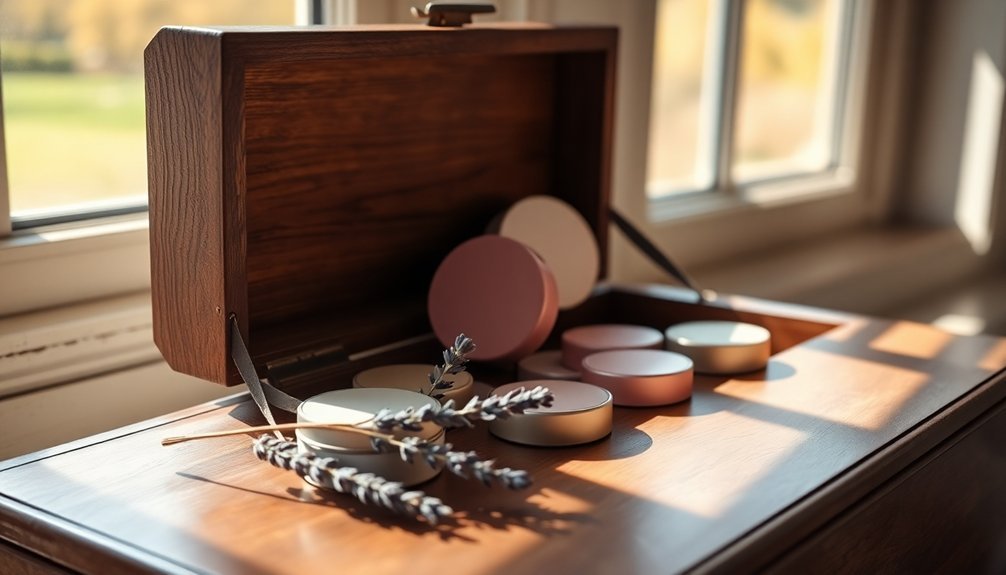
Proper storage habits change considerably with the seasons to protect your solid perfume's integrity.
You'll need to adapt your storage strategy throughout the year, paying special attention during extreme temperature periods. Keep your perfumes at a stable room temperature between 15°C and 25°C, and never leave them in your car where temperatures can soar.
- Store in original packaging away from direct sunlight to prevent fragrance degradation
- Keep in a cool, dry space with consistent temperature – avoid bathrooms and basements
- Confirm containers are tightly sealed to protect against humidity and moisture damage
- Consider using insulated storage solutions during summer months for extra protection
During winter and summer, you'll want to be particularly vigilant about temperature control, as seasonal extremes can alter your perfume's composition and diminish its longevity.
Frequently Asked Questions
Can I Melt and Reformat My Solid Perfume if It Becomes Damaged?
Yes, you can melt and reformat your damaged solid perfume. Just heat it gently and remix the ingredients, but remember that some fragrances may change slightly during this process. Keep it cool afterward for best results.
Are Solid Perfumes Safe to Use During Air Travel?
Yes, you can safely bring solid perfumes on planes. They're not subject to TSA's liquid restrictions, won't leak in your luggage, and don't pose flammability risks. You'll breeze through security with them.
How Do Different Skin Ph Levels Affect Solid Perfume Performance?
Your skin's pH level directly affects how solid perfumes perform. With an ideal pH of 4.5-5.5, you'll get better fragrance adherence and longevity. Higher or lower pH levels can weaken the scent's staying power.
Can I Layer Multiple Solid Perfumes Together for a Unique Scent?
Yes, you can layer solid perfumes! Start with a base scent and add complementary fragrances on top. Experiment with different combinations, but make sure the notes harmonize well for your unique signature blend.
Do Solid Perfumes Stain Clothing or Jewelry When Applied?
You're less likely to experience stains with solid perfumes since they have a wax base and subtle application. However, it's best to let them dry before touching clothes and avoid direct contact with jewelry.





Leave a Reply